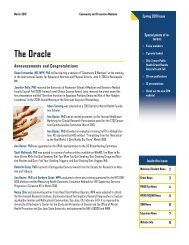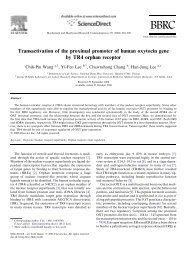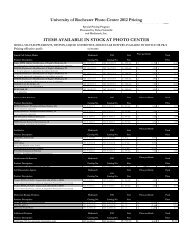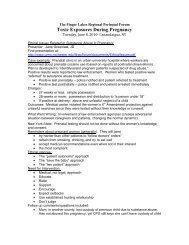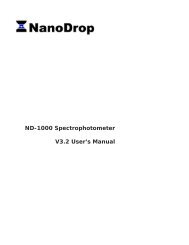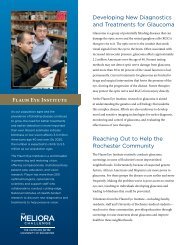Conservative Management of Pelvic Organ Prolapse
Conservative Management of Pelvic Organ Prolapse
Conservative Management of Pelvic Organ Prolapse
Create successful ePaper yourself
Turn your PDF publications into a flip-book with our unique Google optimized e-Paper software.
without risks. However, the existing data are<br />
limited by a lack <strong>of</strong> inclusion criteria and<br />
selection bias. The review recommends that<br />
pessaries be used as an adjunct to cerclage<br />
and not to replace the use <strong>of</strong> cerclages in<br />
the treatment <strong>of</strong> incompetent cervix. 14<br />
Patient Evaluation<br />
HISTORY<br />
The evaluation <strong>of</strong> a patient for a pessary<br />
must be made in the context <strong>of</strong> her daily<br />
activities, level <strong>of</strong> functioning, and the impact<br />
<strong>of</strong> pelvic organ prolapse on her quality <strong>of</strong><br />
life. In addition, the patient’s specific prolapse<br />
symptoms must be identified. As discussed<br />
previously, most symptoms <strong>of</strong> prolapse<br />
(bulge, pressure, discharge, and splinting)<br />
are effectively relieved by pessaries. 5–7<br />
Urinary symptoms have been shown to<br />
improve or worsen with pessaries. Patients<br />
with chronic constipation may have difficulty<br />
retaining a pessary. The pessary may<br />
increase defecation symptoms such as difficult<br />
evacuation.<br />
The patient’s general health status must<br />
also be assessed. Although ideally, a patient<br />
would care for her own pessary, some need<br />
following by a physician for regular pessary<br />
checks. In planning for their follow up, it is<br />
also important to ascertain a patient’s living<br />
situation and their access to medical care.<br />
Undoubtedly, a neglected pessary presents<br />
a clinical dilemma for most physicians<br />
because most <strong>of</strong> these patients are typically<br />
poor surgical candidates. A sexual history<br />
should be included because recent data demonstrates<br />
that sexually active women find<br />
pessaries an acceptable long-term treatment<br />
option. 11 Ultimately, one <strong>of</strong> the most important<br />
components <strong>of</strong> a pessary evaluation is<br />
an assessment <strong>of</strong> the patient’s capacity to understand<br />
the pessary’s function, maintenance,<br />
and the importance <strong>of</strong> medical follow up.<br />
PHYSICAL EXAMINATION<br />
Some <strong>of</strong> the key components <strong>of</strong> the physical<br />
examination pertain to the patient’s pelvic<br />
<strong>Conservative</strong> <strong>Management</strong> <strong>of</strong> <strong>Pelvic</strong> <strong>Organ</strong> <strong>Prolapse</strong> 671<br />
floor strength, severity <strong>of</strong> prolapse, specific<br />
pelvic floor defects, and health <strong>of</strong> the vaginal<br />
epithelium.<br />
<strong>Pelvic</strong> Floor Assessment<br />
Evaluation begins with careful examination<br />
<strong>of</strong> the external genitalia for signs <strong>of</strong> excoriation<br />
and erythema, which may be present<br />
after prolonged complete vault or uterine<br />
prolapse. The size <strong>of</strong> the genital hiatus<br />
(defined as middle <strong>of</strong> the external urethral<br />
meatus to the posterior midline hymen) is<br />
measured, and a size greater than 4 to 5 cm<br />
is generally felt to be enlarged. Vaginal<br />
depth and caliber is estimated by digital vaginal<br />
examination. <strong>Pelvic</strong> floor strength is important<br />
in retaining a pessary, and it is evaluated<br />
by placing 2 fingers in the patient’s<br />
vagina and asking her to perform a Kegel<br />
contraction.<br />
<strong>Prolapse</strong> Severity and Specific <strong>Pelvic</strong><br />
Floor Defects<br />
The severity <strong>of</strong> pelvic organ prolapse and<br />
the site-specific defects are evaluated by<br />
examining a patient in a semirecumbent dorsal<br />
lithotomy position. The patient is asked<br />
to perform a Valsalva maneuver and possibly<br />
cough to demonstrate the maximum extent<br />
<strong>of</strong> the prolapse. If the maximum protrusion<br />
is demonstrated, the vaginal walls will<br />
appear tight, and it is essential to confirm<br />
with the patient if this is the most severe protrusion<br />
that she experiences. If it is difficult<br />
to differentiate which part <strong>of</strong> the vagina is<br />
prolapsing, half <strong>of</strong> a speculum is used to<br />
reduce the prolapse to ascertain which wall<br />
<strong>of</strong> the vagina most prolapsed.<br />
Health <strong>of</strong> the Vaginal Epithelium<br />
Evaluation for vaginal and vulvar atrophy<br />
secondary to estrogen deficiency should be<br />
assessed on examination. Little to no data<br />
is currently available to dictate whether vaginal<br />
atrophy is indeed a contraindication for<br />
pessary fitting. Wu and colleagues 15 reported<br />
on their experience with 110 women who<br />
were prospectively enrolled in a study



